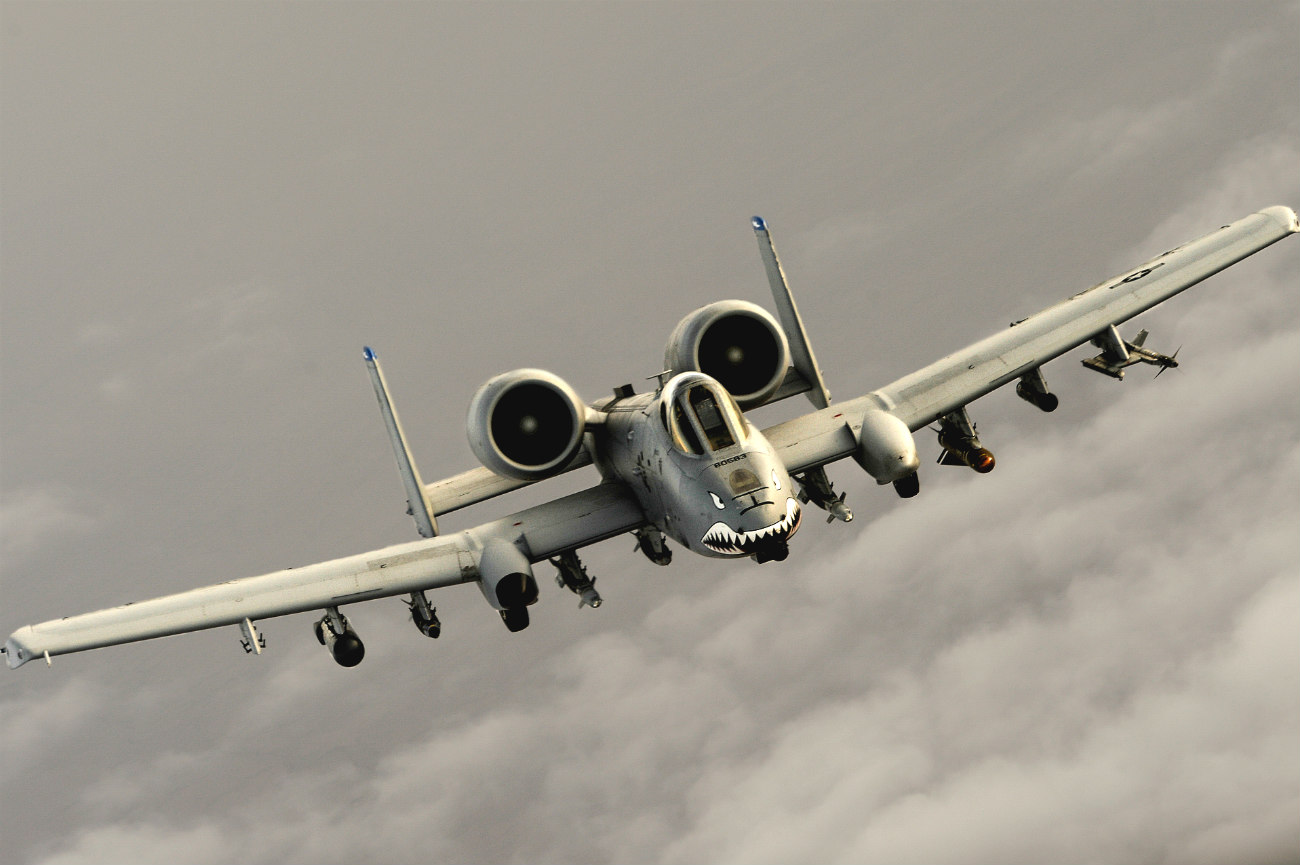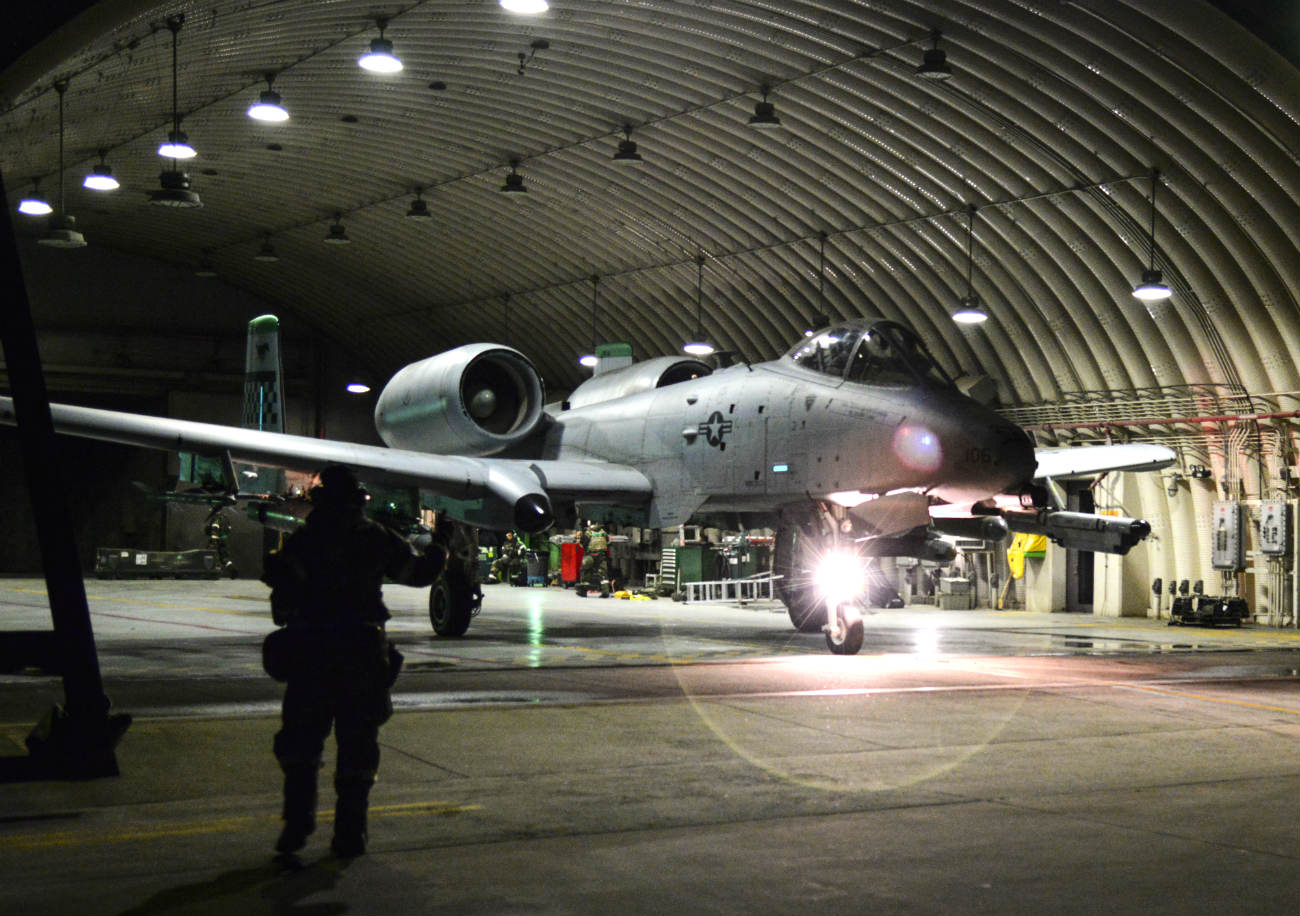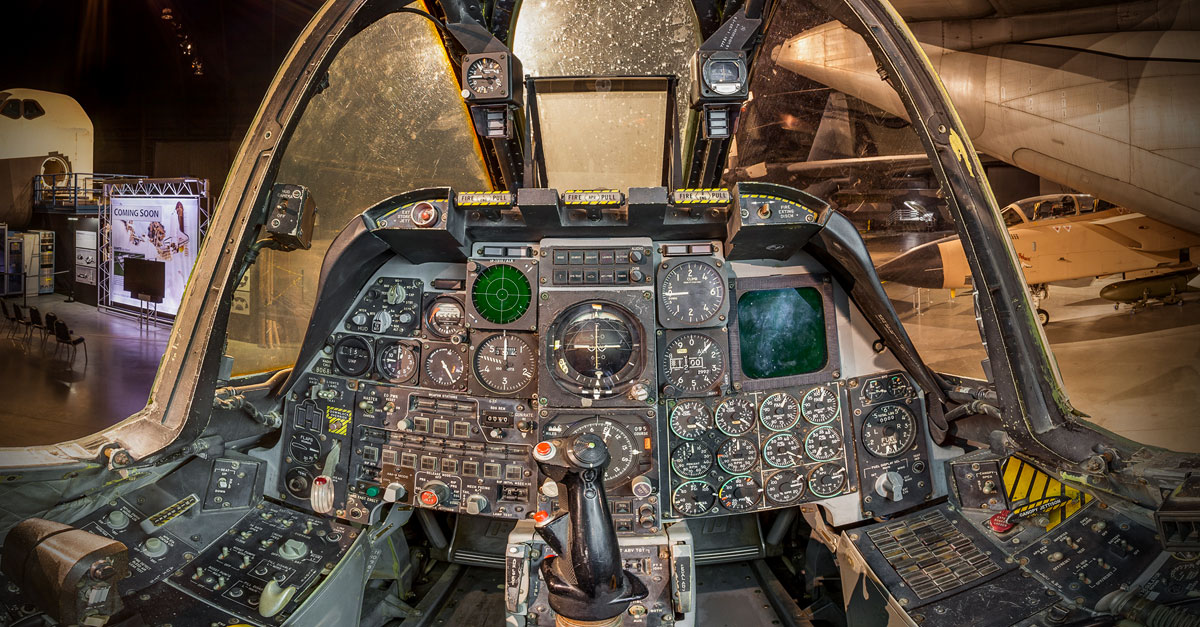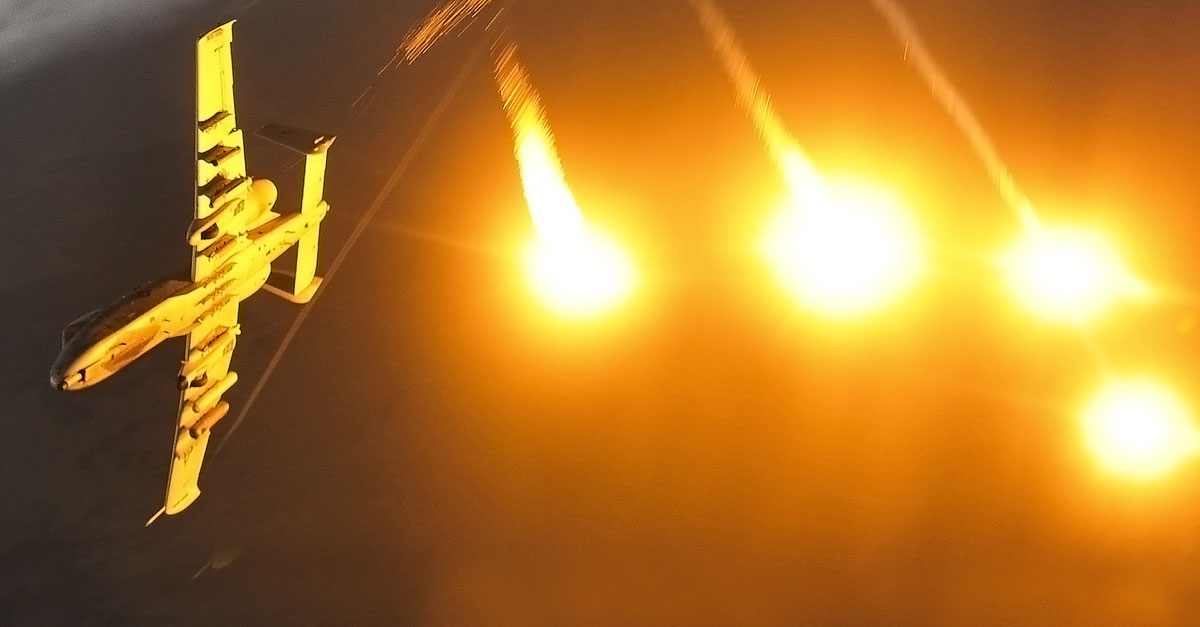A-10 Warthog: 50 Facts About This Legendary Aircraft
The A-10 Warthog. The official designation for this aircraft is the A-10 Thunderbolt II, named after its illustrious WWII predecessor the P-47 Thunderbolt. However, one interesting A-10 fact is that the nickname “Warthog” is so popular and well loved that it appears in official documents. This is a beloved airframe: a robust ground attack aircraft proven time and again in battle. And the stories behind it are just as interesting as its combat record.
The A-10 Warthog Was Designed to Meet the Changing Needs of War

The A-10 Warthog reflects the changing nature of warfare at the time. As the Vietnam conflict developed, it became apparent that the U.S. Military needed a new generation of ground-attack aircraft. These birds must be faster and more robust to deliver firepower to the battlefield while evading enemy fire. The U.S. Army solution was the development of a new generation of attack helicopter, beginning with the AH-1 Cobra and culminating years later with the AH-64 Apache. The Air Force had another idea, and looked for a fixed wing solution. The existing prop-driven attack planes were woefully ill suited, so they took things in a new direction. Enter: The A-10 Warthog.
Fairchild Republic Answered The Required Actions Directive

In 1966 the U.S. Air Force issued a Requirements Action Directive, outlining its needs for a ground attack aircraft and inviting manufacturers to submit a potential design. The requirements were simple but challenging to fulfill. The new aircraft needed to be inexpensive, robust, with payload of 16,000 lbs, a takeoff runway distance of 4,000 feet or less, a long loiter time, excellent low-speed maneuverability and extreme survivability. A company named Fairchild Republic answered the call, and began working on prototypes that would become the A-10 Warthog.
The First Flight Ran Into a Few Glitches

While the A-10 is renown for durability, the first adoption of the aircraft did have a few problems. Davis-Monthan Air Force Base, Ariz. received the first-ever production A-10 in October 1975. When production began in full in 1976, initial fatigue testing failed to meet the new 8,000 hour standard. However, further testing by the engineers at Fairchild Republic found that they needed to reinforce the airframe in order to fix the issue. This was relatively minor. After the correction, 715 airplanes were ordered at the rate of 15 aircraft per month.
The A-10 Almost Did Not Go Into Production

The Air Force nearly chose the Northrop YA-9A over the A-10. The deciding factor came down to YA-9A’s vulnerability left by the engines mounted to the root of the wings, and its single tail.
The Air Force And The U.S. Government Struck A Deal To Keep The A-10 Program Alive

Secretary of Defense James Schlesinger said, in 1973, he would remove a limit on the total amount of wings(think hangers) for Air Force fighters if Air Force General George S. Brown, then the USAF Chief of Staff, would support the A-10 Warthog for years to come.
The A-10 Warthog Has A Secondary Role

The A-10’s secondary role is to provide forward air controller support. In this role, the A-10 pilot would direct other attack aircraft in ground supporting roles – all planes used for this tactic are referenced as OA-10.
The A-10 Warthog’s Unique Design Sets It Apart

The design of the A-10 Warthog is nearly unique. It reflects the aircraft’s mission. The large wing area, large left & right ailerons, and high wing aspect ration all contribute to the A-10’s excellent maneuverability, particularly at low speeds. The A-10 is almost as long as it is wide. The wingspan measures 57 feet 6 inches. The length of the aircraft is 53 feet 4 inches long. The wing design, wheelbase, combined with its oversized turbofan engines, allow the A-10 to take off and land on shorter, primitive airfields. These engineering choices give the aircraft the ability to land as close to the front line of battle as possible. The airframe is designed as a honeycomb structure, which decreases weight while adding strength. This allows the A-10 to fly further and longer in order to engage targets. Also the aircraft’s cockpit bubble canopy allows 360-degree views of the battlefield
The A-10 Warthog Boasts Some Unique Specifications

The A-10 can operate underneath 1,000-foot ceilings with 1.5-mile visibility. This capability, combined with its long loiter time, give the Warthog its ground support capability that earns so much praise. The Warthog also has an internal fuel capacity of 10,000 gallons, giving the A-10 an 800-mile range. The Warthog’s fuel cells self-seal and are protected by anti-explosion foam on the inside and the outside.
The Titanium Bathtub Isn’t For Getting Clean

One of the most interesting A-10 facts deals with its armor. The skin of the aircraft is not structural, and any damage done to it does not compromise the heavily reinforced airframe. The cockpit and flight control functions are the most heavily protected. These are surrounded by 12,000 lbs of titanium aircraft armor in a configuration lovingly referred to as “the titanium bathtub”. Angled to deflect incoming fire, this armor has a nearly flawless track record for keeping pilots safe. Combined with the windscreen and canopy—which are also resistant to small arms fire—the total armor on the aircraft makes up just over 7% of its empty weight. Interestingly enough, the A-10 is so well armored that it can fly through super-cell thunderstorms – the Air Force even uses the A-10 Warthog to monitor severe weather systems.
Twin General Electric Engines Provide Both Power And Maneuverability

The key to the A-10’s success is its design, and that design includes impressive engines. Twin General Electric TF34-GE-100A turbofan engines provide a huge amount of power. They give the A-10 its top speed of 439 miles per hour, with a cruise speed of 300 miles per hour. The stall speed is low for an aircraft of its size—138 miles per hour—allowing the A-10 its superb low-speed maneuverability. In keeping with its ground attack mission, the A-10 has a combat radius of up to 290 miles. This mission also affects engine placement. Due to the potential damage from foreign objects on primitive runways, the engines on the A-10 are placed above the wing rather than below to help shield them. The Air Force designed the A-10 for quick maintenance and turn-around time during battle. The engines being located high on the plane allow them to continue running while receiving support in a forward location.
The A-10 Warthog Has Many Paint Schemes

Since the A-10 Thunderbolt II flies so low to the ground, paint schemes for camouflage are more important here than with other aircraft. Multiple variations have tried – a “peanut scheme” of sand, yellow and field drab, a black and white version for winter work, and a brown, green, and tan version. Many A-10s have shark teeth, or a warthog head painted on the nose of the aircraft.
Some A-10s have a ‘false canopy’ painted on the belly of the aircraft. The diversion is meant to confuse enemy pilots into thinking the paint is actually a shadow cast by the real canopy – hopefully, tricking them into thinking the A-10 is going a different direction at a different altitude.
The A-10 Warthog Was Designed For Survival And Quick Repair

The A-10’s hydraulics systems are double-redundant, and a mechanical backup system controls the plane if the hydraulics is lost. Damaged wing skins can be replaced relatively easy in the field – even with alternative materials. The production skins are not load-bearing, which means replacing them is simple. Engineers even considered the importance of wheel retraction. On the A-10, when the wheels retract, they still slightly protrude outside of the nacelle. The purpose is if the aircraft has to land with its gear up, it will limit damage to a degree. Also the landing gear, engines, vertical stabilizers, and some other parts on the A-10 are left and right interchangeable – meaning they can operate on either side. That allows the aircraft to be serviced at a forward location and put back in combat much sooner than other aircraft.
In 2003, Capt. Kim Campbell’s A-10 was hit by ground fire and took on extensive damage to the horizontal stabilizer, starboard vertical stabilizer, aft fuselage, and engine. She was able to land the plane safely after switching controls to manual and took control of the plane.
The A-10 Can Endure Natural Obstacles

The A-10 is an all-weather, all-day aircraft. The aircraft contains Night Vision Imaging Systems and a goggle-compatible seat in the cockpit.
The A-10 Warthog Carries Weapons Galore

The primary integral weapon of the A-10 Warthog is a nose-mounted 30mm GAU-A8 Avenger Gatling-type Autocannon. In addition to contributing to the Warthog’s iconic look, it also allows a hard-hitting option for both air-to-ground or air-to-air targets. The heavy lifting is done by its disposable munition. With multiple hardpoints, the A-10 can be equipped with everything from bombs to mines to missiles of various sorts. The AGM-65 Maverick is a common choice: a surface-to-air missile that fits perfectly with the A-10’s mission. Remarkably, the A-10 carries more weight in weapons than it weighs itself. The Thunderbolt weighs 12 tons and, including the GAU-8/A cannon, carries a maximum of 13 tons of armament. The weight is even higher when adding AGM-65 missiles, which weigh 670 pounds each and can destroy a tank in a single shot. Bombs are released using precise technology, but the cannon, for the most part, are fired manually.
The A-10 Warthog’s Gatlin Gun Is Large, Heavy And Powerful

The 30 mm GAU-8/A Avenger rests in the front of the aircraft. The front landing gear retracts from under the wings in an offset position, with the rear wheels in line with the fuselage. This set up allows room for the massive weapon. The barrel of the GAU-8/A extends out from the nose of the A-10. It is the heaviest automatic cannon ever mounted on an aircraft.
The Gatling gun accounts for 16 percent of the A-10’s weight. For perspective, the weapon is larger than a Volkswagen bug. During maintenance, sometimes the technicians remove the gun from the aircraft. A support is wedged under the tail to keep the nose from tipping up. The GAU-8/A is manufactured to fire high explosive incendiary and armor-piercing depleted uranium rounds at a rate of 3,900 rounds per minute. These bullets are about the size of beer bottles. When pilots fire the Gatling gun, it heats up quickly and cannot fire for more than a few seconds at a time. Continuing to fire would overheat the barrel and render it ineffective.
The cannon also creates so much smoke while firing that it could choke out a jet engine. The engines, in original testing, could not get enough oxygen while the cannon were firing, so a unique combustion chamber was created to keep the engines running while the gun was firing. Lastly, the recoil from the cannon is so powerful that it affects the airplanes’ trajectory. Therefore, the GAU-8/A 30mm cannon was installed off-center slightly to offset that change caused by the recoil. With the weapon’s massive recoil offsetting the front landing gear from the center, it causes the A-10 Warthog to have an unequal turning radius. Turning right on the ground takes less distance than turning left. The Warthog gun makes a distinctive brrrrt sound when firing.
The A-10 Heads-up Display Has Many Features

The A-10 weapons delivery systems include heads-up displays that indicate altitude, navigation information, dive angle, airspeed, and weapons aiming references. Also, a low altitude safety and targeting enhancement system (LASTE) computes the impact point continuously for free-fall ordnance delivery.
The A-10 Warthog Has An Exclusive Ammunition Loading Vehicle

There is a special vehicle created just for loading ammunition into the A-10 Thunderbolt II. It’s called “The Dragon”.
This Attack Aircraft Is Thoroughly Battle Proven

After a brief deployment during the invasion of Granada, the A-10 first saw real combat during the 1991 Gulf War. With concerns about Iraq’s large and well-equipped armor divisions, the A-10 Warthog became the backbone of the coalition’s close air support. On the second day of the war, two A-10’s destroyed 23 Iraqi tanks across three sorties. The display caused some Iraqi soldiers to refer to the A-10 as the “Cross of Death.” The name likely stems from the plane’s semblance to a cross from underneath. According to official record from the conflict, the A-10 Warthog had a mission capable rate of 85 percent and fired 311,597 rounds of 30 mm ammunition over the course of hostilities. Despite the many dangerous missions flown, only a single Warthog was shot down by the enemy.
This was the auspicious beginning of a long career, as the A-10 is still proving itself effective during the ongoing War on Terror in the Middle East and Afghanistan. As of 2015, the A-10 Thunderbolt has flown about 11 percent of all United States Air Force sorties against ISIS in Syria and Iraq. That’s a reduction from what it flew in Operation Iraqi Freedom and Afghanistan – about 32 percent of the combat sorties in both theaters.
An NFL Player Piloted An A-10

Chad Hennings was a defensive lineman with the Dallas Cowboys after he served in the Air Force piloting an A-10 during the Gulf War.
An A-10 Participated In A Rescue Mission

In 1999, an A-10 assisted in the rescue of a downed F-117 pilot in Kosovo. The A-10 provided ground support while three helicopters executed the rescue mission.
The A-10 Has Seen Many, Many Upgrades

The A-10A single-seat variant was the only model ever produced. As a long-serving aircraft, the A-10 has undergone many upgrades. These chiefly focus on either flight controls or sensors and weapons delivery systems. The first glass cockpits for the A-10 Warthog began in the early 1990s, adding enhanced multifunction displays, computerized autopilot, and a collision warning system. The A-10 was a trend-setter in the late 1970s when it became one of the first ground attack aircraft to use laser-guided munitions. In 2005, an upgrade program was implemented to give all A-10 current avionics and precise bombing technology – these updated models are now known as A-10C. Currently, further upgrades are under discussion, including more powerful engines and an advanced search and rescue locator system.
There Is An A-10 Warthog Monster Truck

The Air Force has an A-10 Thunderbolt monster truck used marketing purposes. It travels around the U.S. and has become a fan favorite at air shows.
The ‘Warthog’ Nickname Has Stuck Around

Initially, the cumbersome appearance of the A-10 gave it the nickname “Warthog.” After many years of successful missions, the “Warthog” is now an affectionate nickname that commends the aircraft’s longevity and grittiness.
A-10 Facts: Sadly, the A-10 Faces an Uncertain Future

Despite its obvious strengths and many accolades, the future of the A-10 Warthog remains uncertain. The aging nature of the fleet led to questions about sustainability at a time when unmanned drones are taking over the ground attack and close air support roles. There is serious discussion about having the F-35 Lightning II perform many of the functions currently handled by the A-10. This has met with serious opposition from within the US Air Force, further complicating any decision making. While there are no definite plans for retirement yet, the days of the A-10 Warthog may, unfortunately, be numbered.
You may also like this A-10 Warthog T-Shirt.

